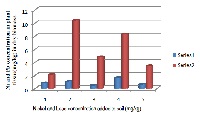Comparative evaluation of Nickel and Lead scavenging efficiency by in-vivo grown Plants using atomic absorption spectroscopy
Keywords:
Phytoremediation, in-vivo growth, atomic absorption, spectroscopy, hyperaccumulatesAbstract
Phytoextraction, the use of hyperaccumulator plant species to scavenge toxic heavy metals from contaminated soils are considered as an emerging technique for cost effective and environment friendly detoxification. The present study was conducted to evaluate and compare the scavenging efficiency of in-vivo grown climber plants, that is Cvcitmis sativus, Armenian cucumber, Lufa acutangula, Momordica charantia descourt and Lagenaria siceraria for the uptake of Nickel and lead using atomic absorption spectroscopy (AAS). Bioassays of field grown (In-vivo) plants were subjected to atomic absorption spectrophotometer for the analysis of scavenging efficiency of the aforementioned elements, after 98 days of growth in soils, contaminated with each of these, separately. The in-vivo grown climber plants absorbed much lesser amounts of Ni, that is, 0.79, 1.05, 0.45 and 1.61 ppm as compared to Pb plants which showed higher ranges of uptake, that is, 2.09, 10.39, 4.77 and 8.29 ppm, respectively. The metal uptake ratios were proportional to their concentrations in the contaminated soils. Maximum uptake for heavy metals was observed by the roots in all plants. Nodes also showed high heavy metal accumulation in the aerial region. Higher concentration of heavy metals in the soil showed a negative effect on their growth.
References
. Awofolu OR. (2005). A survey of trace
metals in vegetation, soil and lower
animals along some selected major
roads in metropolitan city of Lagos.
Environmental Monitoring and
Assessment, 105: pp 431-447.
. Akpor OB, and Muchie M. (2010).
Remediation of heavy metals in drinking
water and wastewater treatment
systems: Processes and applications.
International Journal of the Physical
Sciences, 5(12): pp 1807-1817.
. Raskin I, Smith RD, Salt DE. (1997).
Phytoremediation of metals: using plants
to remove pollutants from the
environment. Current Opinion in
Biotechnol, 8 (2): pp 221.
. Ebbs SD, Kochian LV. (1998).
Phytoextraction of zinc by oat (Avena
sativa), barley (Hordeum vulgare), and
Indian Mustard (Brassica juncea).
Environ. Sci. Technol, 32 (6): pp 802.
. Ansari TM, Ikram N, Najam-ul-Haq M,
Fayyaz I, Fayya Q, Ghafoor I, Khalid
N.,(2004). Essential trace metal (Zinc,
Manganese, Copper and Iron) levels in
plants of medicinal importance. J. Biol.
Sci., 4(2): pp 95-99.
. Steel RGD, Torrie JH. (1980). Analysis
of covariance,in principles and
procedures of statistics: A biometrial
approach, 22 (2) pp 401-437.
. Kartosentono S, Ana N, Gunawan I.
Noor CZ., (2001). Phytoremediation of
Sr2+ and its influence on the growth,
Ca2+ and solasodine content of shoot
culture of Solanum laciniatum.
Biotechnol. Lett. 23(2): pp 153-155.
. Saier Jr MH, and Trevors JT. (2010).
Phytoremediation: Water, Air and Soil
Pollution. J. Biol. Sci, 205 (1), pp 61-63.
. Singh A, Eapen S, and Fulekar MH.
(2009). Potential of Medicago sativa
for uptake of cadmium from
contaminated environment. Romanian
Biotechnology Letters, 14(2): pp 4164-
. Nedelkoska TV, Doran PM. (2000).
Hyperaccumulation of Cadmium byhairy
roots of Thlaspi caerulescens.
Biotechnol. Bioeng., 67(5): pp 607- 615.
. Prasad MNV, De Oliveira FHM. (2003).
Metal hyperaccumulation in plants -
Biodiversity prospecting for
Phytoremediation Technology. Electron.
J. Biotechnol., 6(3). pp566-578.
. Fatima NI, Siddiqui U, Perveen F,
Maqsood ZT. (2004). Among few
commonly used anti diabetic herbs:
Fenugreek is the best. Pak. J. Biol. Sci.,
(6): pp 966-970.
. Sahito SR, Kazi TG, Kazi GH, Jakhran
MA. (2002). Elemental investigation of
Momordica charantia L. and Syzigium
jambolana L. using atomic absorption
spectrophotometer. The Nucleus, 39(1-
: pp 49-54.
. Lin W, Qixing Z, Lingling D, Yuebing S.
(2007). Effect of cadmium toxicity on
nitrogen metabolism in leaves of
Solanum nigrum L. as a newly found
cadmium hyperaccumulator. J. Hazard.
Mater., 154: pp 818-825.
. Soleimani M, Hajabbasi MA, Afyuni M.
Charkhabi A.H., and Shariatmadari H.,
(2009). Bioaccumulation of nickel and
lead by Bermuda grass (Cynodon
dactylon) and tall fescue (Festuca
arundinacea) from two contaminated
soils. Caspian Journal of Environmental
Science, 7 (2): pp 59-70.
. Wu G, Kang H, Zhang X, Shao H, Chu
L, and Ruan C. (2010). A critical review
on the bio-removal of hazardous
heavy metals from contaminated
soils: Issues, progress, ecoenvironmental concerns and
opportunities. Journal of Hazardous
Materials, 174: pp 1-8.


